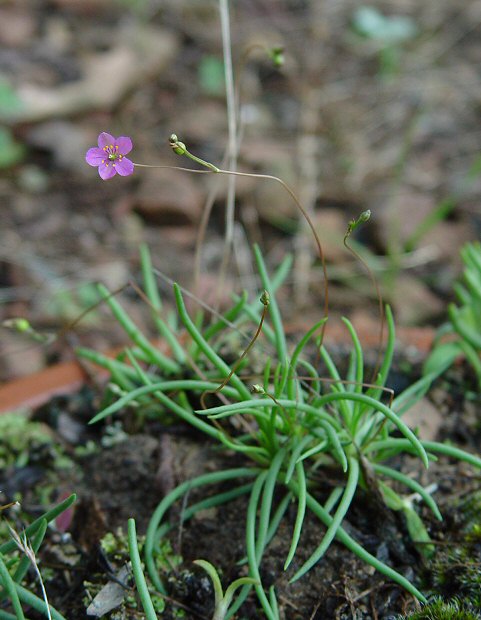Phemeranthus parviflorus (Nutt.) Kiger
Prairie Fame Flower

Native
CC = 10
CW = 5
MOC = 27
© DETenaglia
Phemeranthus parviflorus (Nutt.) KigerPrairie Fame Flower | |
 |
Native CC = 10 CW = 5 MOC = 27 |
© DETenaglia |
|
Family - Portulacaceae Stems - Multiple from the base, short, herbaceous, to 2cm long, from fibrous roots. Leaves - Alternate, dense on the stem, succulent, terete, glabrous, to 5cm long, 2mm in diameter. Inflorescence - Terminal, scapose, bracteate cyme. Peduncles to 20cm tall, slender, glabrous, tan. Pedicels to 5mm long, slightly longer in fruit, expanded just below the flowers, glabrous. Divisions of cyme subtended by scale-like bracts. Bracts scarious, to 2mm long.Flowers - Petals 5, distinct, pinkish-purple adaxially, with some white abaxially, glabrous, to +/-5mm long, 2-2.5mm broad, acute. Stamens 5(4-8), erect, alternating with the petals. Filaments glabrous, 2-3mm long, purple. Anthers yellow, to 1.3mm long. Ovary superior, ovoid, glabrous, -2mm long, 1mm in diameter, 3-valved. Style glabrous, purplish. Placentation free central. Ovules many. Sepals 2, spreading, broadly ovate to orbicular, glabrous, cupped, to 2mm long and broad, entire, greenish-white. Capsule glabrous, to +/-4mm long.
Flowering - May - August. Habitat - Level sandstone and chert glades, rocky outcrops above bluffs. Origin - Native to U.S. Other info. - This little species can be found in the Ozark region of Missouri. The plant is succulent and is well suited for living in dry, hot habitats. The species epithet, parviflorus, means "small flowers" and this species does have smaller flowers than the other species of Phemeranthus in Missouri, P. calycinus. Photographs taken at Dave Rock Conservation Area, St. Clair County, MO., 7-16-05. |